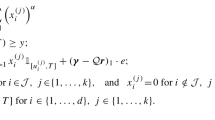Abstract
We investigate the stability of two families of queueing networks. The first family consists of a general class of networks, where service is allotted to the lead customer at each buffer. The other generalizes networks considered by Humes [18], and is related to the insertion of “leaky buckets” into the system. The arguments for the stability of the networks in each case rely on the corresponding behavior for the associated fluid models. This connection is employed using the framework established by Dai [10], with some modifications. It is discussed here in a somewhat more general setting, with future applications in mind.
Similar content being viewed by others
References
V. Anantharam and T. Konstantopoulos, Burst reduction properties of the leaky bucket flow control scheme in ATM networks, IEEE Trans. Commun. 42 (1994) 3085-3089.
M. Bramson, Instability of FIFO queueing networks, Ann. Appl. Probab. 4 (1994) 414-431.
M. Bramson, Instability of FIFO queueing networks with quick service times, Ann. Appl. Probab. 4 (1994) 693-718.
M. Bramson, Two baldy behaved queueing networks, in: Stochastic Networks, IMA Volumes in Mathematics and its Applications, Vol. 71 (Springer, New York, 1995) pp. 105-116.
M. Bramson, Convergence to equilibria for fluid models of FIFO queueing networks, Queueing Systems 22 (1996) 5-45.
M. Bramson, Convergence to equilibria for fluid models of head-of-the-line proportional processor sharing networks, Queueing Systems 23 (1996) 1-26.
M. Bramson, State space collapse with application to heavy traffic limits for multiclass queueing networks, submitted to Queueing Systems (1998).
M. Bramson, A stable queueing network with unstable fluid model, in preparation (1998).
H. Chen, Fluid approximations and stability of multiclass queueing networks: work-conserving disciplines, Ann. Appl. Probab. 5 (1995) 637-655.
J. Dai, On positive Harris recurrence of multiclass queueing networks: a unified approach via fluid limit models, Ann. Appl. Probab. 5 (1995) 49-77.
J. Dai, Stability of open multiclass queueing networks via fluid models, in: Stochastic Networks, IMA Volumes in Mathematics and its Applications, Vol. 71 (Springer, New York, 1995) pp. 71-90.
J. Dai, J. Hasenbein and J. Vande Vate, On the monotone global stability region of a three-station fluid network, preprint (1997).
J. Dai and S. Meyn, Stability and convergence of moments of multiclass queueing networks via fluid models, IEEE Trans. Automat. Control 40 (1995) 1889-1904.
J. Dai and G. Weiss, Stability and instability of fluid models for re-entrant lines, Math. Oper. Res. 21 (1996) 115-134.
M.H.A. Davis, Piecewise deterministic Markov processes: a general class of nondiffusion stochastic models, J. Roy. Statist. Soc. Ser. B 46 (1984) 353-388.
V. Dumas, A multiclass network with non-linear, non-convex, non-monotone stability conditions, submitted to Queueing Systems (1997).
J.M. Harrison, Brwnian models of queueing networks with heterogeneous customer populations, in: Stochastic Differential Systems, Stochastic Control Theory and their Applications, IMA Volumes in Mathematics and its Applications, Vol. 10 (Springer, New York, 1988) pp. 1-20.
C. Humes, A regulator stabilization technique: Kumar-Seidman revisited, IEEE Trans. Automat. Control 39 (1994) 191-196.
S.H. Lu and P.R. Kumar, Distributed scheduling based on due dates and buffer priorities, IEEE Trans. Automat. Control 36 (1991) 1406-1416.
S.P. Meyn and R.L. Tweedie, Stability of Markovian processes III: Foster-Lyapunov criteria for continuous time processes, Adv. in Appl. Probab. 25 (1993) 518-548.
S.P. Meyn and R.L. Tweedie, State-dependent criteria for convergence of Markov chains, Ann. Appl. Probab. 4 (1994) 149-168.
S. Rybko and A. Stolyar, Ergodicity of stochastic processes that describe the functioning of open queueing networks, Problems Inform. Transmission 28 (1992) 3-26 (in Russian).
T.I. Seidman, “First come, first served” can be unstable!, IEEE Trans. Automat. Control 39 (1994) 2166-2171.
A. Stolyar, On the stability of multiclass queueing networks, in: Proc. 2nd Conf. on Telecommunication Systems — Modeling and Analysis, Nashville (1994) pp. 1020-1028.
R.J. Williams, Diffusion approximations for open multiclass queueing networks: sufficient conditions involving state space collapse, submitted to Queueing Systems (1998).
Author information
Authors and Affiliations
Rights and permissions
About this article
Cite this article
Bramson, M. Stability of two families of queueing networks and a discussion of fluid limits. Queueing Systems 28, 7–31 (1998). https://doi.org/10.1023/A:1019182619288
Issue Date:
DOI: https://doi.org/10.1023/A:1019182619288




